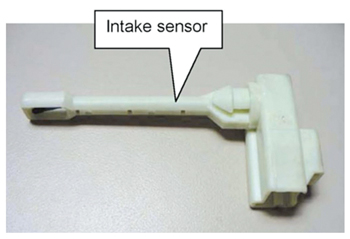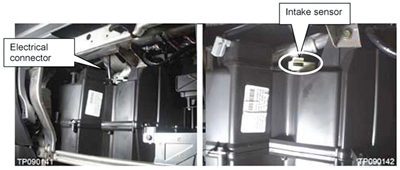Applicable model(s):
2004-’08 Quest (V42)
2005-’11 Xterra (N50)
2005-’11 Pathfinder (R51)
2005-’11 Frontier (D40)
2004-’08 Titan (A60)
2004-’08 Armada (TA60)
If you confirm one of the above vehicles has low airflow coming from the HVAC front air vents due to evaporator freeze-up, and the HVAC unit surface temperature around the evaporator is about 32° F (0° C), causing ice to form on the evaporator, follow the Service Procedure below, which involves replacing the intake sensor (see Fig. 1) with P/N 27700-ZC00A. Note: The incident may be described as occurring only after a long drive with the HVAC on continuously and the blower set on low and under conditions such as high ambient temperature and high humidity.
Service Procedure:
For Titan and Armada, follow the procedure outlined in this bulletin for intake sensor replacement.
For Quest, Xterra, Frontier and Pathfinder, refer to the appropriate section in the electronic service manual for intake sensor replacement.
1. Remove the six bolts from the glove box.
2. Remove the glove box. The intake sensor is located behind the glove box.
3. Disconnect the intake sensor electrical connector. See Fig. 2.
4. Remove the intake sensor by pulling it up and out from the front heater and cooling unit assembly.
5. Install the new intake sensor in reverse order of removal and connect the intake sensor electrical connector.
6. Install the glove box in reverse order of removal.
Courtesy of Mitchell.







